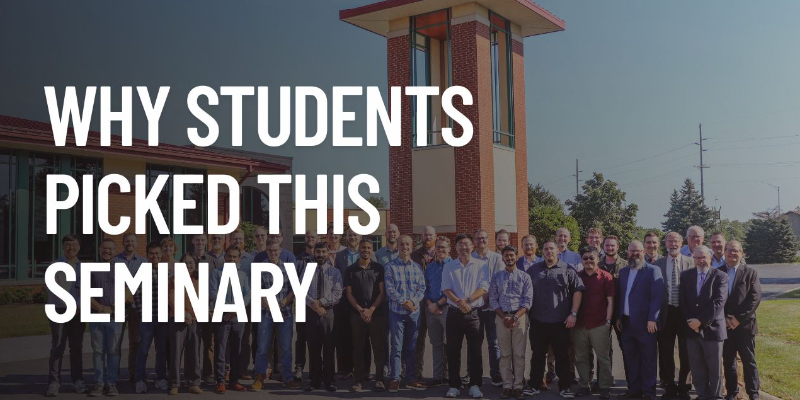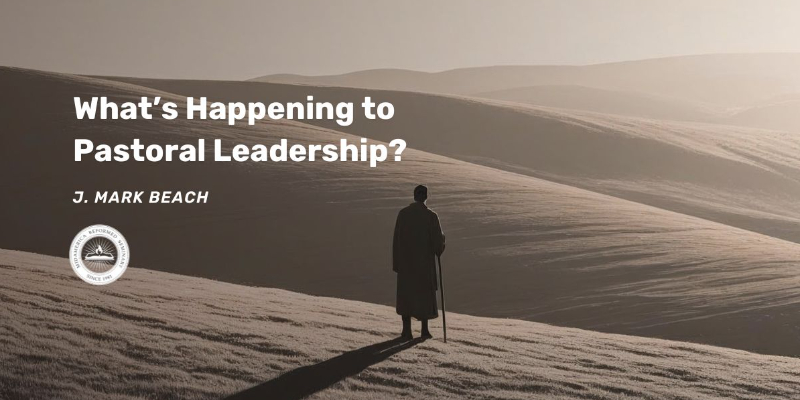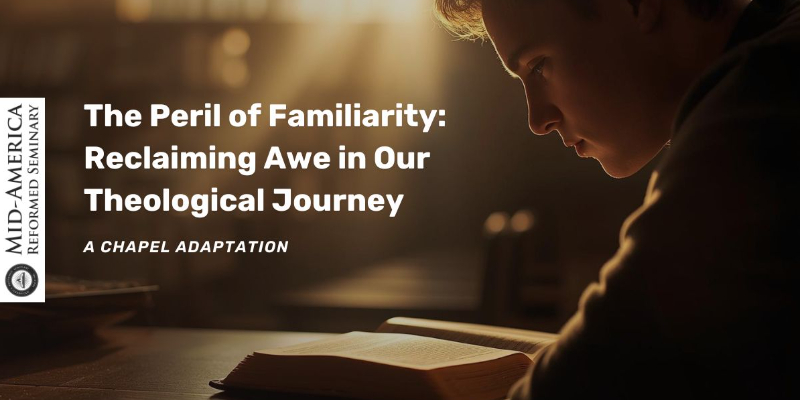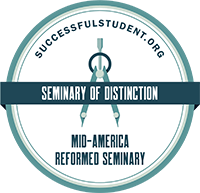
Creation as God's Temple
This article is an arrangement of the academic convocation address given on Wednesday, August 29, 1984, at the beginning of the Mid-America Reformed Seminary school year of 1984-85.
I have chosen as my topic, "Creation as God's Temple." For some of you, this may be a hackneyed subject. For others, this may be an exploration of new and exciting territory. But that is the duty of teachers versed in the Kingdom of heaven. They must bring out things both new and old. I have subtitled my topic of "Creation as God's Temple" as follows: "The redemptive-historical significance of the disappearance of the temple." You will see, I trust, what all that entails.
In the Anglican and Episcopalian liturgy of communion, after the absolution, during the thanksgiving, the priest will say: It is very meet, right, and our bounden duty, that we should at all times, and in all places, give thanks unto Thee, O' Lord, Holy Father, Almighty, Everlasting God, Creator and Preserver of all things. Therefore with Angels and Archangels, and with all the company of heaven, we laud and magnify Thy glorious Name; evermore praising Thee and saying: "Holy, Holy, Holy, Lord God of hosts. Heaven and earth are full of Thy glory. Glory be to Thee, O Lord of hosts."
There are several things in this liturgical item to notice. First, thanks is to be rendered always and everywhere to Almighty God. Thus the liturgy is extended beyond the place of the cult to every part of time and space. Secondly, the worshipper is joining earth to heaven (angels and all its hosts) in the liturgical response of thanks. And thirdly, you will recall that the specific doxology quoted above, the Trisagion, dates back to a prophetic commissioning service, that of Isaiah, son of Amoz, as recorded for us in Isaiah 6. Isaiah was in the temple one day, and, as it were, the roof seems to lift off to allow heaven to join the earth momentarily in one majestic worship service. Isaiah sees the Lord, sees and hears the mighty seraphim, and has his lips purged so that he could preach the word of the Lord to the covenant people. This happened in the temple.
To understand the idea of "creation as God's Temple," we must examine the more familiar microcosm, the Solomonic temple, and to a lesser extent, its predecessor, the tabernacle, built during the desert wanderings. Having a grasp of what the temple proper was, we can extend that understanding to the creation.
A temple, of course, was not a uniquely Israelite phenomenon. Archaeological excavations at Megiddo and at Hazor have uncovered Canaanite temples similar in floor plan to the Solomonic temple. The Hebrew word for temple is the word hekhal, a word which can also be translated as "palace." In Near Eastern palaces that have been uncovered, mighty cherubim figures with lion bodies, eagle wings, and human faces guarded the way to the throne room. Cherubim were protectors of the mighty king. At times cherubim themselves were thrones or even footstools of the pagan, semi-divine rulers. But the Jerusalem temple was unique in that God's people placed no idol in it at any point. The Lord made that stipulation quite clear. There were never to be any graven images used as objects of worship.
In its structure, the temple was a stationing of its moveable forebear, the tabernacle. At the same time, it was more complex and ornamented. Three principal areas composed the temple. The ulam was the porch or outer court. It was reached by passing through the two standing pillars, Jachin and Boaz, the so-called "shoulders" of the temple.
The holy place was the Temple proper, or the hekhal, accessible only to the purified priests of God.
The third section of God's house was the perfect cube, the so-called devir or holy of holies. This was a windowless room filled with the very presence of God. Only the high priest could enter once a year, his approach being signaled by soft tinkling of bells. This was a call to the covenant God, who dwells in light inaccessible, to be merciful to this servant. The high priest was to present the blood of sacrifice to the Lord by sprinkling this blood upon the mercy seat on the ark of the covenant, which was guarded by two mighty cherubim.
What the furniture of the temple was is important. I will say little about it since that falls outside my area of concern. Nor am I so concerned about the details of size and measurement. These matters have their own interests, but I will bypass them now.
Our interest here is what the temple represented in the life of God's covenant people. One could ask: "Was the temple a place of dwelling or worship?" The book of Deuteronomy, in several places, records God's intention to choose one place in the promised land where His Name would dwell. Deuteronomy 12:5-7 is representative of a number of passages that express this:
But you are to seek the place the LORD your God will choose from among all your tribes to put His Name there for His dwelling. To that place you must go; there bring your burnt offerings and sacrifices, your tithes and special gifts, what you have vowed to give and your freewill offerings, and the firstborn of your herds and flocks. There, in the presence of the LORD your God, you and your families shall eat and rejoice in everything you have put your hand to, because the LORD your God has blessed you.
The Psalms also frequently echo this idea from Deuteronomy that the temple is the dwelling place of the LORD. "The LORD is in His holy temple; the LORD is on His heavenly throne. . ." (Ps. 11:4). From the Davidic Psalm 18 (pre-temple!), we read, "In my distress I called to the Lord; I cried to my God for help. From His temple He heard my voice; my cry came before Him, into His ears. The earth trembled. . .He parted the heavens and came down; dark clouds were under His feet. He mounted the cherubim and flew..." In this last quoted psalm, the reference is to heaven, under the symbol of the temple. Heaven is God's dwelling. The temple on earth is one visible abode for the transcendent, heavenly Lord. The temple is even comparable to a footrest. "Let us go to His dwelling place; let us worship at His footstool" (Ps. 132:7).
But the dwelling is given greater focus. It is where God's Name dwells and the abode where His Glory lives. This recalls the moments both in the wilderness and at the temple dedication when the fiery, cloudy pillar, the luminescent Shekinah, filled the inner court, even causing the Solomonic liturgy of dedication to grind to a halt, because of the brightness of the Glory, a cloud manifesting God's immanence. His direct presence is surrounded by the noisy guardian cherubim (II Chron. 5:14; 7:1-3). When the priests saw the fire and the glory of the LORD above the temple, they knelt and worshiped.
This worship motif is embodied in the psalter of God's people. Psalm 26:8 reads, "I love the house where you live, o LORD, the place where Your Glory dwells." Psalm 63:2 says something similar: "I have seen You in the sanctuary and beheld Your power and Your glory." God is unseen and unseeable until He reveals Himself in His Name and in His Glory. And in the Old Testament tabernacle and temple, this is what He did. And the response is always to be worship.
Hence to put the question thus—is the temple a place of dwelling (with the focus on who is there) or a place of worship (with the focus on what is done there)—can be superseded by the more comprehensive statement: a temple is a place where the holy God of glory dwells to meet His people, coming in either covenant blessing or covenant curse. The response to His presence is almost always worship, reverence, and awe as God thunders the judgment word of blessing or curse from His glorious throne.
The emphasis then falls not first of all upon the building itself, but on the Glorious Presence of the LORD, and then secondarily, although still very importantly, on the presence of a people who are to tremble in godly fear. If the emphasis on the temple is, first of all, on the building structure, then the Glorious Presence is subject to man's manipulation. This is essentially a pagan notion. Such a notion infected Israel during the time of judge Eli and his sons Hophni and Phineas. These two sons thought that by bringing the ark of the covenant against the Philistines, they could manipulate the sovereign Lord to their advantage. To Israel's painful dismay, the God of Glory is not held in a box or even on a box, not even on the ark of the covenant. Indeed in the wilderness, Israel broke camp and moved on when the glorious cloud of God's Presence moved on, neither too soon nor too late. Hundreds of years later, Ezekiel saw the Spirit leave Jerusalem to join the exiles in Babylon to be a sanctuary for them there (cf. Ezek. 11:16). It is more to the point to say that in the Glorious Presence is our sanctuary rather than to say that in our sanctuary is the Glorious Presence.
This is borne out by the vision of Isaiah referred to earlier in Isaiah 6. "I saw the Lord seated on a throne, high and exalted." It could have been that in this vision, the veil of the temple parting allowed Isaiah to see the glorious liturgy in the Holy of Holies. But what seems more likely is that the roof, as it were, is parted to allow Isaiah insight into heaven where the mighty seraphs, six-winged burning angels, cry out the great Trisagion. The temple of Isaiah 6 can only contain the train of His robe, which manifests as smoke or cloud. And the place trembles at the thunderous seraphic choir.
The Glorious Presence of God cannot be contained in a building. Isaiah 66, following hard and fast on a description of the holy mountain, which is the new creation (new heavens and new earth), records this word of the LORD, "'Heaven is my throne and the earth is my footstool. Where is the house you will build for me? Where will my resting place be? Has not my hand made all these things, and so they came into being?' declares the LORD."
Now in the minds of some theologians of the critical tradition, such sentiments reflect the prophetic stance against the concerns of a priestly character. In critical theology, the priestly character represents forms, rituals, and cults. In tension with this is the prophetic character, say the critics, a character that stands outside of forms and precise definitions, having ethical, supposedly more social, covenantal concerns.
Hence from this kind of a paradigm (and Old Testament theology today is still largely rife with it), a man of great ability like Walther Eichrodt can say that in priestly circles, the glory of the Lord, the kavodh Yahweh, is transcendent, "the divine majesty unapproachable by human sight." But in priestly circles, the kavodh Yahweh, the glory of God, is "the reflected splendor of the transcendent God." So in priestly theology, the glory of God, the fiery Shekinah cloud, becomes a form, dwelling in the Temple, immanent, in which God appears for the purposes of revelation.
What this does, of course, is to put Scripture into inherent, internal contradictions because of the presence of conflicting theologies, a position we cannot in any way endorse. Besides that, Eichrodt appears to be saying that in the religion of Israel, there was tension between God's transcendence (the prophetic) and His immanence (the priestly). From the Scriptural point of view, this is a philosophical problem of our making, but it is not a tension reflected in the life of God's people. From the biblical-theological point of view, the question falls into proper perspective when the so-called differences are seen in the light of the forward movement and development of both redemptive history and redemptive revelation. The transcendent God of glory has revealed Himself and has come to dwell among His people. Immanuel ("God with us") never loses His sovereign transcendence, even in His immanence. Or, as Dr. Klaas Schilder says so well in his very important study of heaven, Heaven—What is It?, "To believe His immanence when He reveals it is to tremble before His transcendence." Such is reflected in both the priestly and prophetic aspects of the Old Testament.
But to move on, one cannot help but be impressed with what appears to be almost a restlessness of God when it comes to His dwelling in the Temple. He dwells there, to be sure, but it cannot contain Him. Even Solomon said at the temple dedication, "But will God really dwell on earth? The heavens, even the highest heavens, cannot contain You. How much less this temple I have built!" Meredith G. Kline, in his fascinating book, Images of the Spirit, suggests that this three-layered universe is a vertical model or pattern for the horizontal copy, the tabernacle and the temple. Earth (belonging to man) is the outer court, heaven is the holy place (the hekhal), and the heaven of heavens is the Holy of Holies. Structurally speaking, the creation is an archetype of the temple. Or, to put it another way, the temple is a type of creation. And Solomon says, even that cannot contain Him.
The Psalms and the prophets often speak of the Glorious Presence of the LORD as being spread over the land, especially among the nations. According to the Old Testament revelation, this Glorious Presence must impel the nations to acknowledge the LORD in praise, in loyal service, and in worship, usually by stating that they would come to Jerusalem, to the temple where the Name dwelt. This is not overzealous Israeli nationalism being expressed, but a perfectly proper statement in the light of the redemptive-historical epoch. Jerusalem must be the goal of the nations in the Old Testament types and shadows because salvation is of the Jews. At the temple is God's Name; there are the ordained priests; there are the prescribed sacrifices; there, the nations may learn the distinction between the holy and the profane, the clean and the unclean.
Yet this point must not be lost. Creation is a temple when the Glory is present, and there is a faithful response among the people. The Old Testament sees this. Psalm 66:1,2 reads, "Shout with joy to God, all the earth! Sing to the glory of His Name... All the earth bows down to You; they sing praise to You ..." Psalm 72:19 says, "Praise be the LORD God . . . Praise be to His glorious Name forever; may the whole earth be filled with His glory. Amen and Amen!" Isaiah echoes these ideas. "And the glory of the LORD will be revealed, and all mankind together will see it" (Isa. 40:5). "From the west men will fear the name of the LORD, and from the rising of the sun, they will revere His glory" (Isa. 59:19). "Arise, shine for Your light has come .... Nations will come to Your light" (Isa. 60:1,2).
In Habakkuk 2:14, there is that stirring prophecy that the earth shall be full of the knowledge of the glory of the Lord as the waters cover the sea. God is beyond the Jerusalem temple, beyond Israel even, beyond the earth, restless in a sense to fill the earth with the glorious Shekinah, which is His Name dwelling with us, so that every knee will bow, in heaven and on earth and under the earth. All the creation temple responds to the glorious Name of God with us.
The prophet Habakkuk also references the creation serving as a temple. Habakkuk 2:20 says, "The Lord is in His holy temple; let all the earth keep silent before Him." Although many could identify the temple here with the Jerusalem sanctuary, that does not seem likely. The temple is heaven (see Ps. 11:4; 18:6,9), the throne room, the place of power and authority. D. Martyn Lloyd-Jones comments, "Let us realize that He is there in the temple of the universe, God over all." The earth's response to His presence in the heavenly Temple is a hushed silence.
Contrast this hushed silence with the response to the thundering, earth-shattering Lord in Psalm 29. The "mighty ones" are to ascribe to Him glory and strength, worshiping with Holy Spirit splendor on them. The sevenfold voice of the LORD comes rolling in from the Mediterranean, over Lebanon, and then on to Kadesh. Then in verse 9c, we read, "And in His temple all cry, 'Glory.'" The Jerusalem Temple could be the reference, but when the action of the LORD is nowhere near the city, the strong likelihood is that the temple of verse 9 is something other than Jerusalem's holy sanctuary. The "mighty ones" all cry "Glory." In God's temple, there is a time to be hushed, and there is a time to be crying "Glory."
Many more passages could be cited, analyzed, and exegeted. But a picture emerges. For redemptive-historical purposes, a temple needed to be built for God's covenant people. Yet the LORD inspires His Scripture writers to let Israel know full well that He has larger designs for creation (the heavens and the earth) and for the nations in it. His wise counsel includes the salvation and historical calling of His elect people. They are called to serve the Lord in every area of life. To achieve this, the people of God everywhere need the glorious Spirit. And in God's plan such is given. Predestination always includes glorification (cf. Rom. 8:30).
Hence the temple in Jerusalem must pass away so that a more normative situation may ensue. Or, to put it another way, the stones of the temple must be cast down so that what God's glorious Spirit was itching to do in the Old Testament, namely, convert the nations and thereby transform life into Paradise, He can now do.
Such seems to be the import of some of Jesus' penetrating remarks to the Samaritan woman in John 4. She had said, "Our fathers worshiped on this mountain, but you Jews claim that the place where we must worship is in Jerusalem" (John 4:20). Jesus' response was, "Believe me, woman, a time is coming when you will worship the Father neither on this mountain nor in Jerusalem" (John 4:21). He does not name a new mountain or a new city, but He does name a new "temple," a new people. Verse 23 says, "Yet a time is coming and has now come when the true worshipers will worship the Father in spirit and truth, for they are the kinds of worshipers the Father seeks . . . God is Spirit, and they that worship Him must worship Him in spirit and in truth" (John 4:24). It is in the spirit of true worshipers that God the Spirit can and will reside. Hence the Spirit now makes the Church of Jesus Christ the temple of the living God. The Jerusalem temple must go so God's original intention might be further pursued. Jesus' temple (His body) is destroyed and rebuilt to build His Church. The Roman destruction of Jerusalem, including Herod's temple, also signals, albeit in a gruesome way, the advance towards the completion of heaven's and earth's history.
And that brings us to Mid-America Reformed Seminary. This school of the prophets (and priests and kings, I might add) exists in the second of history's great time slots. In the first period, before Christ's first Parousia, shadows and types exist with people living by faith. In the third period, after the second Parousia, reality is present, and we live by sight. But now, between the two Parousias, God's Temple-Church has the realities of Jesus Christ, His Word, and Spirit leading and living in us. But we still walk by faith. We still need to say to one another and to all mankind, "Know the Lord." We do not yet see the glory of God filling the earth. We do not see all things under man's feet as God intended in Paradise. The liturgical word "serve," as in "serve the LORD with gladness," is also the word used in Gen 2—"Work the ground!" "Develop this Garden-Temple" is the command before the Church-Temple.
This convocation is a calling together of men who have a calling in creation or, more pointedly, a calling in re-creation. The choice is not between engaging in the culture or preaching the Word of the Lord. The tension is not grace versus nature. But it is God's grace against our sin and overcoming that sin. We are not, says Schilder, fully dead or fully risen. Eternity has entered our time, and we have tasted it already in this world. We are new temples who labor in the Temple of the Holy Spirit for the sake of God's Temple of Garden and City.
As I said, the choice is not between preaching the Word and doing culture. As Schilder points out in his book Christ and Culture, preaching is also a task of great cultural importance. And Schilder was not thinking of sociology at that point. He was pressing home Isaiah 55 and Romans 10. Preaching the Word has this aim: to transform lives to transform life. For us to be temples in the new creation, which is God's Temple, God must dwell with man in peace, in covenant, and in glory.
We do not yet see all things in subjection to man. But we do see Jesus, now crowned with glory (!). We are not here at Mid-America to train social workers, ecclesiastical politicians, or clinical psychologists. We are here to train godly men in the Word so that they may preach that Word so that obedient service in the creational temple may be done.
The loss of Jerusalem's temple was not a diminishing in the amount of holiness, but it was a necessary step to make even the bells on the horses holy to the LORD and to render washpots fit for Temple service. As William Cowper, the poet said:
Jesus, where'er Thy people meet,
There they behold Thy mercy seat;
Where'er they seek Thee, Thou art found.
And every place is hallowed ground.

Mark Vander Hart is Associate Professor of Old Testament Studies | Ministerial Apprenticeship Program Director | Dean of Students.
Recent articles




